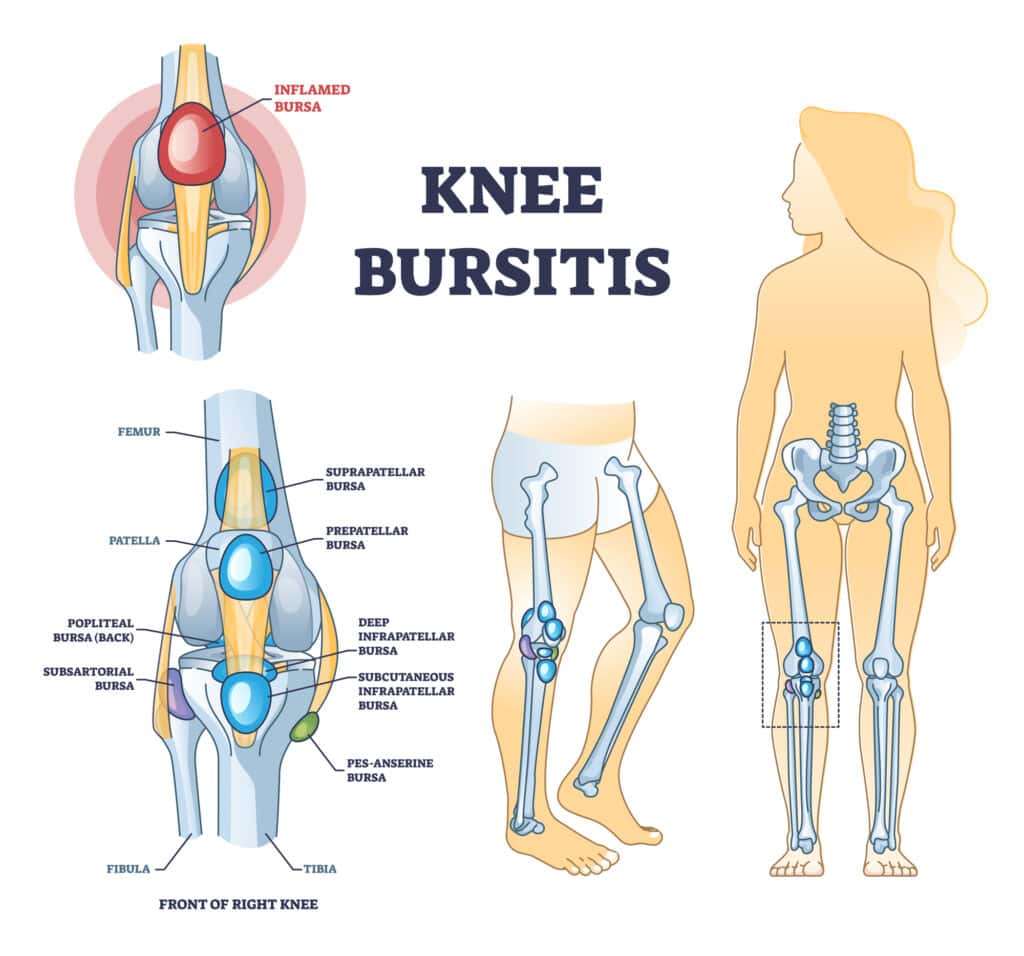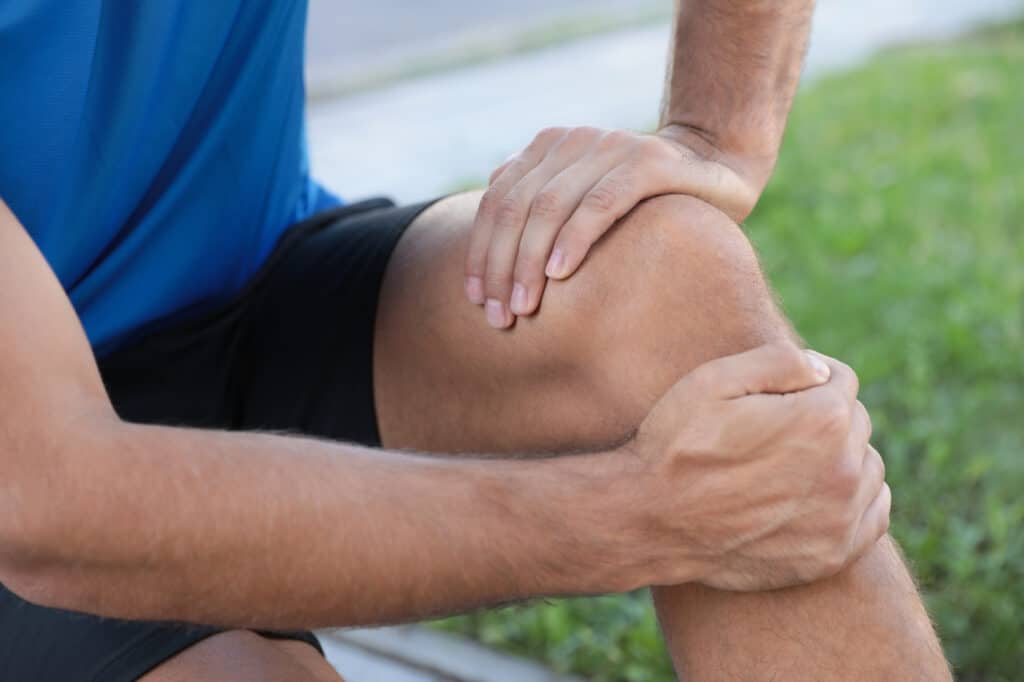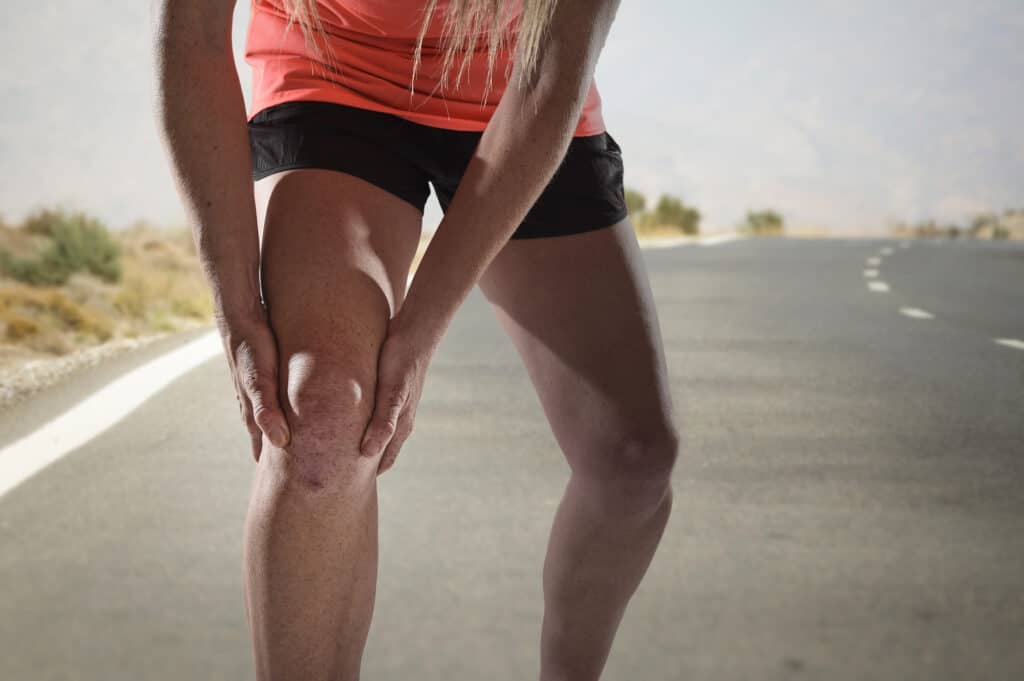
Do you have swelling around your knee joint?
Do you feel pain in your knee, especially when climbing stairs or kneeling?
Are you wondering whether it’s a muscle sprain, strain, or maybe even arthritis?
Unfortunately, many of us think, “Oh, it’s just a muscle strain or sprain. It’ll get better in a few days” when we have pain somewhere in the body and often put off getting treatment. But have you considered that the cause of your knee pain could be something called knee bursitis?
We know it’s likely that you’ve never heard of it before. But we regularly diagnose knee bursitis at the Apex Orthopedic Rehabilitation clinic. This condition occurs when the bursae or tiny fluid-filled sacs surrounding the knee joint become inflamed. The bursae provide a cushion between bones and muscles.
Still, they can become irritated due to repetitive movements or pressure on the knee.
While this type of inflammation is most often seen in athletes who participate in activities requiring repetitive motion, it can also occur in anyone with underlying inflammatory conditions like arthritis or certain autoimmune diseases.
More Articles From Apex
What Is The Cervical Spine, And Is It The Cause of my pain?
Can I Get Immediate Relief For Sciatica Pain?
What Is Causing Pain In My Shoulder?
What Are The Symptoms Of Knee Bursitis?
Knee bursitis is a painful condition caused by inflammation of the bursae in the knee joint. The common symptoms of knee bursitis can include pain, swelling, and tenderness around the kneecap.
There may also be redness, warmth, tenderness over the knee, stiffness, aching, and difficulty bending the knee. It’s a particularly challenging condition for active people – like athletes, runners, or anyone who regularly engages in physical activity that involves the knees.
The most common symptoms of knee bursitis we see in the clinic are:
- Pain in the front or back of the knee that worsens when putting pressure on it: Knee pain can be a real hassle, especially if it gets worse when you put pressure on it. The front or back of your knee might hurt, making walking, climbing stairs, or even standing for long periods difficult. Unfortunately, knee pain is a common issue that affects people of all ages and lifestyles. Knee pain can be a nuisance whether you’re an athlete or spend long hours sitting at a desk.
- Swelling around the knee: When it comes to injuries or infections, swelling around the affected area is common, a common symptom of knee bursitis. Various factors, including the build-up of fluids, inflammation, and tissue damage, can cause it. Swelling can be quite uncomfortable and even painful. Sometimes, it can signal a more serious underlying issue, such as an infection or a fracture. So, if you notice swelling around an injury or infection, it’s important to contact a physical therapist to get a proper diagnosis to rule out any potential complications.
- Stiffness in the joint and difficulty bending the knee: Stiffness in the joint and difficulty bending the knee can be frustrating and painful, making it difficult to perform your everyday activities. Whether it’s from arthritis or knee bursitis, the stiffness can limit your range of motion and make it harder to enjoy life. Walking, climbing stairs, and even sitting down can become a challenge. Fortunately, there are ways we can alleviate the discomfort and improve your flexibility, so you can regain mobility and get back to doing the things you love.
- Redness and warmth to the touch: When it comes to our bodies, any redness and warmth is usually a sign that something isn’t quite right. These symptoms often go together with inflammation, which can be caused by various factors such as infections, injuries, knee bursitis, and autoimmune disorders. Regardless of the cause, paying attention to these signs and seeking medical attention if necessary is important. While it’s tempting to ignore them and hope they go away on their own, doing so could lead to further health complications, as it could be an infection.
- Difficulty putting weight on the leg when walking or standing: Walking and standing are basic functions we perform without a second thought. But what happens when putting weight on one leg becomes a challenge? Our mobility and confidence take a hit. Difficulty putting weight on the leg when walking or standing can have various causes, like joint problems, muscle weakness, nerve damage, an injury, and knee bursitis. Whatever the reason, it’s essential to identify the root cause. Ignoring it can lead to compensatory movements that can cause problems in other parts of your body. Remember, your body is a complex machine, and every part needs to work in unison to enable you to move well.
What Causes Knee Bursitis?
Knee bursitis, also known as prepatellar bursitis, is a common condition mainly affecting people who engage in physical activities that put pressure on their knees, including athletes and laborers.
It occurs when the bursae cushion the knee joint and become inflamed or irritated due to repetitive the stress or injuries sustained during sports or while at work.
When the bursae become irritated or damaged, they can fill with excess fluid and cause pain, swelling, and stiffness in the affected area.
Several factors can cause knee bursitis, including overuse or repetitive movements, repeated stress, direct trauma to the knee, and infection. Certain medical conditions, such as arthritis and gout, can also increase your risk of knee bursitis.
If left untreated, knee bursitis can become chronic and cause severe pain, swelling, and limited mobility. So, it’s important to consult a physical therapist when symptoms appear.
What Is The Treatment for Knee Bursitis?
While knee bursitis may feel overwhelming at times, it can leave you feeling hopeless because it can affect your mobility and ability to bend and straighten your knee, preventing you from working, exercising, and playing sports.
But don’t worry. There are treatment options to help ease the pain, relieve stiffness and discomfort, and get you moving well again without pain.
The immediate first step when pain occurs is to rest and avoid activities that put pressure on your knee. Ice can also reduce swelling and discomfort. But if the pain persists for over a week, we recommend contacting a physical therapist for help.
How Does Physical Therapy Help With Knee Bursitis?
Physical therapy offers innovative treatments to reduce the symptoms of knee bursitis and help you get back on track with your daily life, including modalities like stretching exercises, manual therapy techniques, TENS units, and other effective treatment methods. It is proven to be extremely effective in managing knee bursitis symptoms.
By working with a physical therapist, you learn targeted exercises to strengthen the muscles surrounding the knee and help reduce inflammation. We also educate you on proper body mechanics to prevent further injury at home or during physical activity.
To strengthen the muscles around your knee, there are a variety of exercises we use that are beneficial. One of these exercises is the “straight leg raise,” which targets the all-important quadriceps muscle. Another helpful exercise we use is the “seated knee extension,” whereby you sit with your leg extended and raise the foot upwards.
Additionally, we may get you to practice squats and lunges to improve your overall leg strength and stability. But these exercises should only be done under supervision when you have knee bursitis – when we have professionally evaluated your knee stability, due to the risk of further injury.
We then determine the best exercises for your needs and abilities and incorporate the exercises into a plan to increase your knee joint stability and mobility.
Prevention Tips for Avoiding Knee Bursitis In The Future
Knee bursitis can be painful, limit your mobility and disrupt your daily activities, so it’s best to avoid it. You can take several preventative measures to prevent a recurrence of knee bursitis and stop future flare-ups.
One of the most important tips is to avoid repetitive motions or overuse of your joints. If you have a job or hobby that requires constant movement, take frequent breaks to rest and stretch your muscles.
Another effective measure is to wear proper footwear and knee pads during physical activities or work that involves kneeling. Maintaining a healthy weight and regular exercise can also decrease your risk of developing knee bursitis again. Stretching before and after physical activity can also help prevent injury and reduce inflammation.
If you commit to preventing future problems with proper positioning and technique during activities and taking proactive steps for swelling reduction, you’ll find yourself better equipped to avoid bursitis issues in the future.
But if you do experience a bursitis flare-up, it’s important to rest the affected joint and apply ice to reduce swelling, and seek help from a physical therapist if the pain doesn’t go away in a couple of days.






